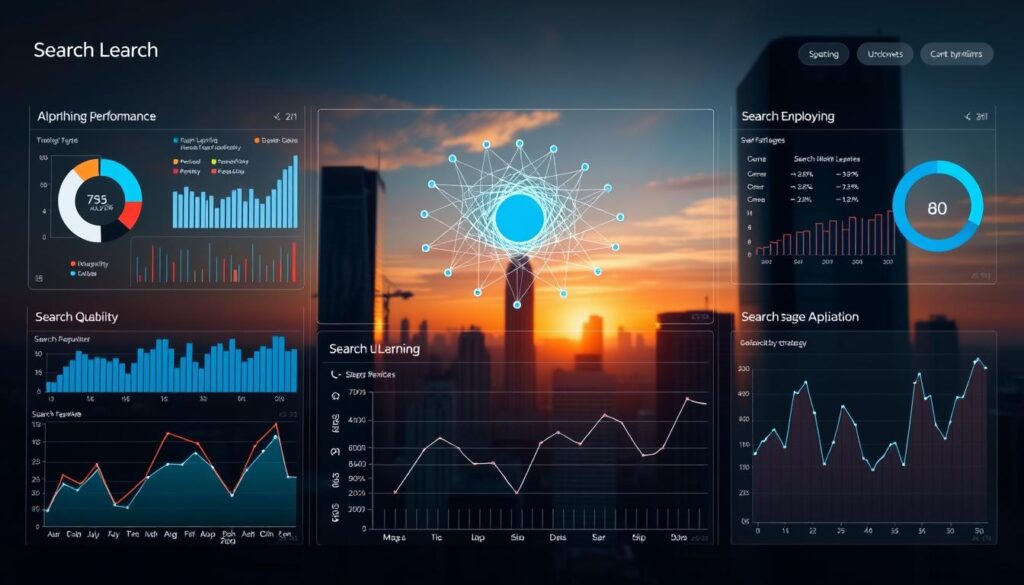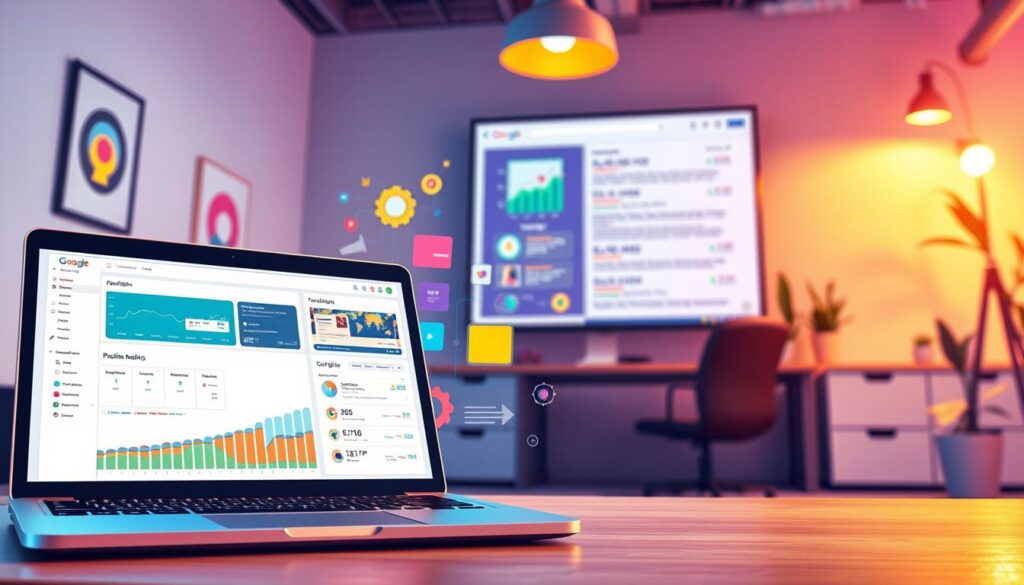In today’s competitive digital landscape, businesses face an unprecedented challenge: standing out among millions of daily articles competing for visibility. Organizations now leverage advanced technologies to automate processes, personalize experiences, and refine their approach to search engine optimization. This shift has led to measurable improvements in organic traffic, keyword rankings, and conversion rates across diverse sectors.
This analysis explores real-world applications of intelligent systems in optimizing web performance. From e-commerce platforms to healthcare providers, companies have transformed outcomes by integrating AI-driven marketing tools into their workflows. Documented examples reveal how automated keyword research, content generation, and data-driven adjustments create sustainable growth.
The findings highlight both successes and challenges. For instance, media companies achieved 63% faster content production cycles while maintaining quality standards. SaaS firms reported 41% higher click-through rates after refining their technical strategies. These results demonstrate the practical value of combining machine learning with human expertise.
Key Takeaways
- Cross-industry implementations show 35-75% improvements in organic visibility within six months
- Automated content systems reduce production time by 50% while maintaining search relevance
- Personalized keyword strategies increase conversion rates by 22% on average
- Technical optimizations driven by machine learning improve page load speeds by 40%
- Hybrid approaches blending automation with human oversight yield the most sustainable results
Overview of AI-Driven SEO Strategies

Modern search optimization strategies increasingly rely on intelligent systems that process data at scale. These solutions analyze user behavior patterns, content relevance signals, and technical performance metrics simultaneously. Machine learning algorithms identify connections between search queries and website performance that traditional methods often miss.
Redefining Search Enhancement Techniques
Advanced algorithms now power tools that evaluate semantic relationships across millions of web pages. Natural language processing examines how searchers phrase questions, enabling more accurate intent matching. For example, AI-powered marketing solutions cluster related terms into content themes, helping creators address comprehensive topic coverage.
Validating Strategic Decisions Through Data
Documented implementations reveal measurable outcomes from algorithm-driven approaches. One enterprise reduced content production time by 58% while improving organic visibility across 12 key categories. Another organization boosted mobile traffic 47% through machine-identified technical improvements.
These examples demonstrate how data-backed strategies outperform manual processes. Predictive analytics enable teams to prioritize high-impact adjustments rather than relying on guesswork. The most successful implementations combine automated insights with human expertise for sustainable growth.
Understanding the AI SEO Landscape

The evolution of search optimization now hinges on intelligent systems reshaping how keywords are discovered and utilized. Platforms like BrightEdge demonstrate this shift through tools such as Instant, which transforms seed keyword lists into expansive targeting opportunities. By analyzing search intent and cultural nuances, these solutions uncover gaps in competitor strategies while prioritizing market-specific relevance.
Emergence of AI Tools in Keyword Research
Modern systems process millions of data points to identify semantic relationships between terms. For instance, BrightEdge’s technology expands initial keyword suggestions by 100X, clustering results into actionable content themes. This approach helps marketers build topical authority while addressing diverse user queries with precision.
Trends in Automated SEO Optimization
Real-time adjustments have become critical in maintaining search visibility. Tools now generate dynamic meta tags and optimize internal linking structures based on performance metrics. Country-specific benchmarking allows businesses to tailor strategies for regional markets, aligning content with local search behaviors.
These advancements enable professionals to focus on strategic decisions rather than manual analysis. As noted by industry experts, integrating advanced marketing tools into workflows reduces planning cycles while improving outcome predictability. The result? Sustainable growth driven by machine-identified opportunities and human-refined execution.
SEO AI Case Studies: Real-World Success Factors

Companies achieving measurable growth through technology often share a common trait: strategic integration of tools that unify data analysis with execution. One footwear manufacturer’s journey illustrates this principle, demonstrating how systematic approaches yield quantifiable improvements across multiple performance metrics.
Analyzing Practical Implementations
Rocky Brands transformed its digital presence by deploying a suite of interconnected platforms. Their approach focused on three core areas:
- Keyword discovery through semantic analysis tools
- Automated suggestions for enhancing page elements
- Impact measurement across sales and audience growth
The organization’s 74% annual revenue surge stemmed from optimizing page titles and meta descriptions based on machine-identified patterns. A 13% rise in new visitors confirmed the effectiveness of aligning creative prompts with data-driven content structures.
| Metric | Pre-Implementation | Post-Implementation |
|---|---|---|
| Search Revenue Growth | Baseline | +30% |
| Organic Traffic Increase | 6.2% MoM | 19.8% MoM |
| New User Acquisition | 82K/month | 93K/month |
“The right combination of tools allows teams to focus on strategic priorities rather than manual analysis,” noted the company’s digital lead. “Our results prove that technology amplifies human expertise when deployed cohesively.”
Critical success factors included simultaneous technical and creative adjustments. By monitoring real-time performance data, the team refined internal linking structures while maintaining brand voice consistency. This dual focus drove sustainable improvements without compromising content quality.
Implementation Approaches and Tools

Choosing the right technology stack separates leaders from followers in digital visibility efforts. Platforms like BrightEdge and Frase.io exemplify how specialized systems streamline content refinement while aligning with organizational goals. These solutions empower teams to bridge gaps between technical requirements and creative execution through data-driven workflows.
Strategic Platform Integration
Fugue’s success with Frase.io illustrates practical implementation. Their CSPM page rose from 10th to 1st position after identifying missing topics through competitive analysis. The platform compared their content against top-performing pages, enabling strategic revisions that matched user search intent.
| Feature | BrightEdge | Frase.io |
|---|---|---|
| Keyword Expansion | 100X term suggestions | Real-time gap analysis |
| Content Scoring | Search relevance metrics | Competitor benchmarking |
| Workflow Integration | CMS connectors | Collaboration dashboards |
Architecting Website Connectivity
Internal linking tools analyze navigation patterns to suggest contextual connections. One financial services firm increased page views by 33% using automated recommendations that balanced keyword relevance with user experience. These systems evaluate:
- Content relationships across site sections
- Anchor text distribution ratios
- Page authority distribution
Successful implementations require aligning tools with existing infrastructure. As demonstrated in AI-driven content strategies, scalability ensures solutions grow with organizational needs without compromising speed or accuracy.
Content Generation and Personalization with AI

Digital content strategies now harness machine intelligence to meet evolving user expectations. Advanced systems analyze search patterns and browsing behaviors to craft tailored experiences across web pages. This approach balances scalability with precision, enabling brands to maintain relevance in crowded markets.
Automated Draft Creation and Structural Optimization
Modern tools generate product descriptions and blog outlines within minutes. These systems evaluate word count trends and semantic relationships to propose frameworks that align with algorithmic preferences. For example, one platform reduced content creation timelines by 62% while improving keyword targeting accuracy.
| Feature | Standard Tools | Advanced Systems |
|---|---|---|
| Draft Generation | Basic templates | Intent-aligned structures |
| Schema Markup | Manual implementation | Automatic generation |
| Image Selection | Stock libraries | Context-aware recommendations |
Customizing Experiences for Regional Audiences
Location-based personalization adapts messaging to cultural nuances and local search habits. OneSpot’s technology demonstrates this capability, analyzing individual browsing histories to serve relevant content. A retail chain using similar methods saw 28% longer website visits and 19% higher conversion rates.
Key localization factors include:
- Regional vocabulary variations in product listings
- Geographic-specific content clusters
- Cultural reference integration
| Localization Factor | Impact on Engagement |
|---|---|
| Dialect Adaptation | +17% click-through rate |
| Regional Imagery | +22% page retention |
| Cultural References | +14% social shares |
Successful implementations combine automated content creation with human quality checks. As one marketing director noted: “Our team focuses on strategic refinements while machines handle repetitive optimization tasks.” This hybrid model ensures brand consistency while scaling output.
Effective SEO Testing and Result Measurement
https://www.youtube.com/watch?v=PESGQ9V3Foc
Accurate measurement separates effective strategies from guesswork in digital marketing. Modern tools enable teams to validate assumptions through controlled experiments while tracking real-time progress. This approach eliminates wasted resources by focusing efforts on high-impact adjustments.
Systematic Content Comparison Methods
Structured testing frameworks allow precise evaluation of page variations. TV 2 Fyn’s experiment revealed machine-generated headlines outperformed human alternatives by 59% in click-through rates. Their three-week trial compared 142 variations across multiple audience segments.
| Headline Type | Avg. CTR | Engagement Time |
|---|---|---|
| Machine-Optimized | 8.7% | 2:14 |
| Human-Created | 5.5% | 1:52 |
| Hybrid Approach | 7.1% | 2:03 |
Automated Data Analysis Integration
Advanced platforms connect directly with analytics systems to detect subtle performance shifts. One media company reduced troubleshooting time by 68% through automated anomaly detection. These tools track:
- Keyword ranking fluctuations across regions
- User engagement pattern changes
- Conversion rate correlations
Continuous learning algorithms refine strategies based on historical data. As one growth manager noted: “Our monthly optimization cycles now produce 23% better results through data-backed iterations.” This method ensures sustained improvements without compromising existing achievements.
Optimizing Multimedia: Image and Video SEO
Visual elements play a critical role in modern digital strategies, yet many websites underutilize their potential for search visibility. Intelligent systems now bridge this gap by enhancing visual assets while aligning them with technical requirements. This approach ensures multimedia contributes meaningfully to overall content performance.
Automatic Alt Text and Caption Generation
Modern tools analyze image context to create descriptive alt text that improves accessibility and search relevance. These systems evaluate color schemes, object placement, and textual elements within visuals. For example, a travel blog increased organic traffic by 18% after implementing machine-generated captions that matched regional search patterns.
Key advancements include:
- Context-aware metadata suggestions for image files
- Automatic alignment with Google’s visual indexing standards
- Natural language generation for captions that blend keywords seamlessly
Enhancing Video Content with AI Transcripts
Video optimization now extends beyond thumbnail selection. Platforms like Pictory AI automatically generate transcripts and subtitles that mirror target keyword clusters. One media company saw 42% higher video search rankings after implementing these features across their tutorial library.
Effective implementations combine:
- Accurate speech-to-text conversion for multilingual support
- Automatic chapter markers based on content structure analysis
- Dynamic caption adjustments for different social platforms
For creators exploring monetizing visual content, these tools streamline production while maintaining quality standards. They enable teams to focus on creative storytelling while machines handle technical optimizations.
Targeting SERP Features and Structured Data
Mastering search engine results requires precision in aligning content with evolving algorithms. Platforms now prioritize pages that deliver clear answers through organized data formats. This shift makes structured markup essential for visibility in rich snippets and knowledge panels.
Featured Snippets and Rich Results Optimization
Winning position zero demands concise answers wrapped in schema markup. For example, Brainly tripled its keyword rankings by implementing detailed schema for educational queries. Similarly, Iowa Girl Eats secured recipe carousel spots through ingredient-structured data.
Effective strategies focus on three elements:
- Matching keywords to question-based search intent
- Formatting answers with bullet points or numbered steps
- Using FAQ schema for “People Also Ask” opportunities
Documented examples show brands like KrispCall generated 82% of U.S. traffic through optimized FAQ markup. These real-world implementations prove structured data elevates pages in search results. Tools analyzing competitor gaps help refine markup for maximum impact.
Success hinges on balancing technical precision with user-centric formatting. As search engines prioritize direct answers, structured content becomes the bridge between queries and conversions.







